A bright number chart representing numbers 1-20.
These number charts can be used for various number and counting activities during guided math groups.
Print on cardstock, then cut and distribute to students. There are three boards on a page.
Updated: 28 Jul 2023
A bright number chart representing numbers 1-20.
Non-Editable: PDF
Pages: 1 Page
Grades: PK - 1
Write numbers from 0 to 20. Represent a number of objects with a written numeral 0-20 (with 0 representing a count of no objects).
Understand the relationship between numbers and quantities; connect counting to cardinality.
When counting objects, say the number names in the standard order, pairing each object with one and only one number name and each number name with one and only one object.
Understand that the last number name said tells the number of objects counted. The number of objects is the same regardless of their arrangement or the order in which they were counted.
Understand that each successive number name refers to a quantity that is one larger.
Identify whether the number of objects in one group is greater than, less than, or equal to the number of objects in another group, e.g., by using matching and counting strategies.
Compare two numbers between 1 and 10 presented as written numerals.
Represent addition and subtraction with objects, fingers, mental images, drawings1, sounds (e.g., claps), acting out situations, verbal explanations, expressions, or equations.
Solve addition and subtraction word problems, and add and subtract within 10, e.g., by using objects or drawings to represent the problem.
Decompose numbers less than or equal to 10 into pairs in more than one way, e.g., by using objects or drawings, and record each decomposition by a drawing or equation (e.g., 5 = 2 + 3 and 5 = 4 + 1).
Use addition and subtraction within 20 to solve word problems involving situations of adding to, taking from, putting together, taking apart, and comparing, with unknowns in all positions, e.g., by using objects, drawings, and equations with a symbol...
Apply properties of operations as strategies to add and subtract.2 Examples: If 8 + 3 = 11 is known, then 3 + 8 = 11 is also known. (Commutative property of addition.) To add 2 + 6 + 4, the second two numbers can be added to make a ten, so 2 + 6 + 4 ...
Understand subtraction as an unknown-addend problem. For example, subtract 10 - 8 by finding the number that makes 10 when added to 8.
Add and subtract within 20, demonstrating fluency for addition and subtraction within 10. Use strategies such as counting on; making ten (e.g., 8 + 6 = 8 + 2 + 4 = 10 + 4 = 14); decomposing a number leading to a ten (e.g., 13 - 4 = 13 - 3 - 1 = 10 - ...
10 can be thought of as a bundle of ten ones - called a "ten."
The numbers from 11 to 19 are composed of a ten and one, two, three, four, five, six, seven, eight, or nine ones.
Add within 100, including adding a two-digit number and a one-digit number, and adding a two-digit number and a multiple of 10, using concrete models or drawings and strategies based on place value, properties of operations, and/or the relationship b...
Count forward and backward to at least 20 with and without objects;
Read, write, and represent whole numbers from 0 to at least 20 with and without objects or pictures;
Count a set of objects up to at least 20 and demonstrate that the last number said tells the number of objects in the set regardless of their arrangement or order;
Generate a set using concrete and pictorial models that represents a number that is more than, less than, and equal to a given number up to 20;
Generate a number that is one more than or one less than another number up to at least 20;
Compare sets of objects up to at least 20 in each set using comparative language;
Use comparative language to describe two numbers up to 20 presented as written numerals; and
Compose and decompose numbers up to 10 with objects and pictures.
Model the action of joining to represent addition and the action of separating to represent subtraction;
Solve word problems using objects and drawings to find sums up to 10 and differences within 10; and
Explain the strategies used to solve problems involving adding and subtracting within 10 using spoken words, concrete and pictorial models, and number sentences.
Use concrete and pictorial models to compose and decompose numbers up to 120 in more than one way as so many hundreds, so many tens, and so many ones;
Use concrete and pictorial models to determine the sum of a multiple of 10 and a one-digit number in problems up to 99;
Use objects and pictorial models to solve word problems involving joining, separating, and comparing sets within 20 and unknowns as any one of the terms in the problem such as 2 + 4 = [ ]; 3 + [ ] = 7; and 5 = [ ] - 3;
Compose 10 with two or more addends with and without concrete objects;
Apply basic fact strategies to add and subtract within 20, including making 10 and decomposing a number leading to a 10;
Explain strategies used to solve addition and subtraction problems up to 20 using spoken words, objects, pictorial models, and number sentences; and
Generate and solve problem situations when given a number sentence involving addition or subtraction of numbers within 20.

A bright number chart representing numbers 1-20.
These number charts can be used for various number and counting activities during guided math groups.
Print on cardstock, then cut and distribute to students. There are three boards on a page.
Write numbers from 0 to 20. Represent a number of objects with a written numeral 0-20 (with 0 representing a count of no objects).
Understand the relationship between numbers and quantities; connect counting to cardinality.
When counting objects, say the number names in the standard order, pairing each object with one and only one number name and each number name with one and only one object.
Understand that the last number name said tells the number of objects counted. The number of objects is the same regardless of their arrangement or the order in which they were counted.
Understand that each successive number name refers to a quantity that is one larger.
Identify whether the number of objects in one group is greater than, less than, or equal to the number of objects in another group, e.g., by using matching and counting strategies.
Compare two numbers between 1 and 10 presented as written numerals.
Represent addition and subtraction with objects, fingers, mental images, drawings1, sounds (e.g., claps), acting out situations, verbal explanations, expressions, or equations.
Solve addition and subtraction word problems, and add and subtract within 10, e.g., by using objects or drawings to represent the problem.
Decompose numbers less than or equal to 10 into pairs in more than one way, e.g., by using objects or drawings, and record each decomposition by a drawing or equation (e.g., 5 = 2 + 3 and 5 = 4 + 1).
Use addition and subtraction within 20 to solve word problems involving situations of adding to, taking from, putting together, taking apart, and comparing, with unknowns in all positions, e.g., by using objects, drawings, and equations with a symbol...
Apply properties of operations as strategies to add and subtract.2 Examples: If 8 + 3 = 11 is known, then 3 + 8 = 11 is also known. (Commutative property of addition.) To add 2 + 6 + 4, the second two numbers can be added to make a ten, so 2 + 6 + 4 ...
Understand subtraction as an unknown-addend problem. For example, subtract 10 - 8 by finding the number that makes 10 when added to 8.
Add and subtract within 20, demonstrating fluency for addition and subtraction within 10. Use strategies such as counting on; making ten (e.g., 8 + 6 = 8 + 2 + 4 = 10 + 4 = 14); decomposing a number leading to a ten (e.g., 13 - 4 = 13 - 3 - 1 = 10 - ...
10 can be thought of as a bundle of ten ones - called a "ten."
The numbers from 11 to 19 are composed of a ten and one, two, three, four, five, six, seven, eight, or nine ones.
Add within 100, including adding a two-digit number and a one-digit number, and adding a two-digit number and a multiple of 10, using concrete models or drawings and strategies based on place value, properties of operations, and/or the relationship b...
Count forward and backward to at least 20 with and without objects;
Read, write, and represent whole numbers from 0 to at least 20 with and without objects or pictures;
Count a set of objects up to at least 20 and demonstrate that the last number said tells the number of objects in the set regardless of their arrangement or order;
Generate a set using concrete and pictorial models that represents a number that is more than, less than, and equal to a given number up to 20;
Generate a number that is one more than or one less than another number up to at least 20;
Compare sets of objects up to at least 20 in each set using comparative language;
Use comparative language to describe two numbers up to 20 presented as written numerals; and
Compose and decompose numbers up to 10 with objects and pictures.
Model the action of joining to represent addition and the action of separating to represent subtraction;
Solve word problems using objects and drawings to find sums up to 10 and differences within 10; and
Explain the strategies used to solve problems involving adding and subtracting within 10 using spoken words, concrete and pictorial models, and number sentences.
Use concrete and pictorial models to compose and decompose numbers up to 120 in more than one way as so many hundreds, so many tens, and so many ones;
Use concrete and pictorial models to determine the sum of a multiple of 10 and a one-digit number in problems up to 99;
Use objects and pictorial models to solve word problems involving joining, separating, and comparing sets within 20 and unknowns as any one of the terms in the problem such as 2 + 4 = [ ]; 3 + [ ] = 7; and 5 = [ ] - 3;
Compose 10 with two or more addends with and without concrete objects;
Apply basic fact strategies to add and subtract within 20, including making 10 and decomposing a number leading to a 10;
Explain strategies used to solve addition and subtraction problems up to 20 using spoken words, objects, pictorial models, and number sentences; and
Generate and solve problem situations when given a number sentence involving addition or subtraction of numbers within 20.

We create premium quality, downloadable teaching resources for primary/elementary school teachers that make classrooms buzz!
Would you like something changed or customised on this resource? While our team makes every effort to complete change suggestions, we can't guarantee that every change will be completed.
Did you spot an error on this resource? Please let us know and we will fix it shortly.
Are you having trouble downloading or viewing this resource? Please try the following steps:
If you are still having difficulty, please visit the Teach Starter Help Desk or contact us .

30 game boards to use when practicing the doubles plus one strategy with single and double-digit numbers.
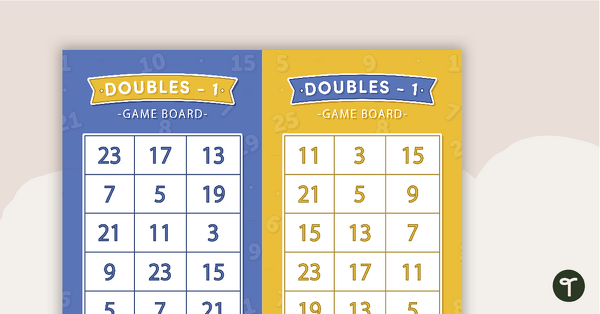
30 game boards to use when practicing the doubles minus one strategy with single and double-digit numbers.
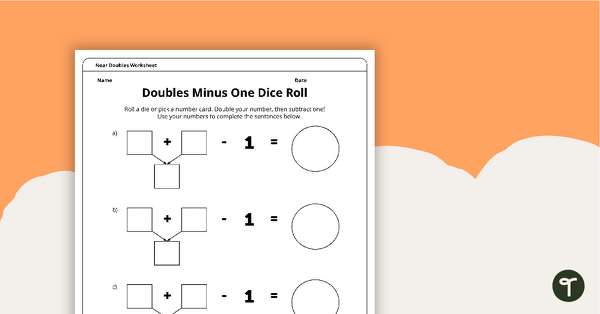
Practice the doubles minus one addition strategy with this one-page worksheet.
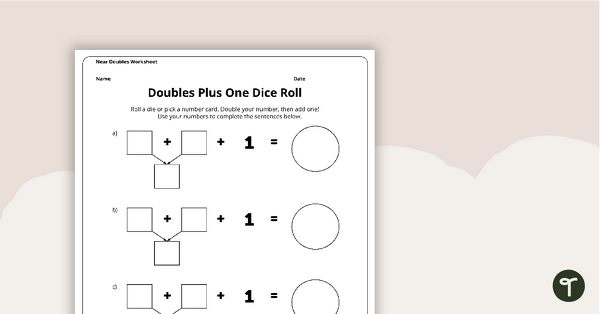
Practice the doubles plus one addition strategy with this one-page worksheet.
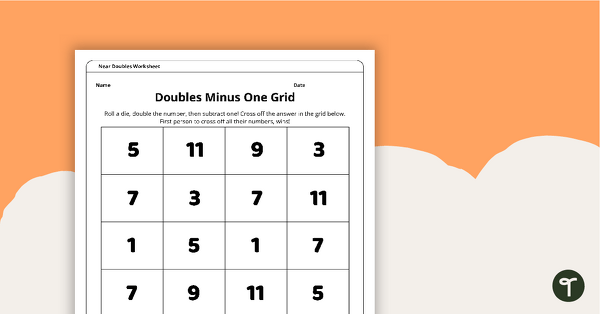
Practice the doubles minus one addition strategy with this dice game.
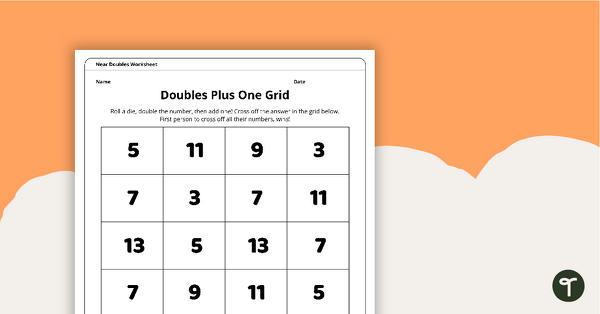
Practice the doubles plus one addition strategy with this dice game.
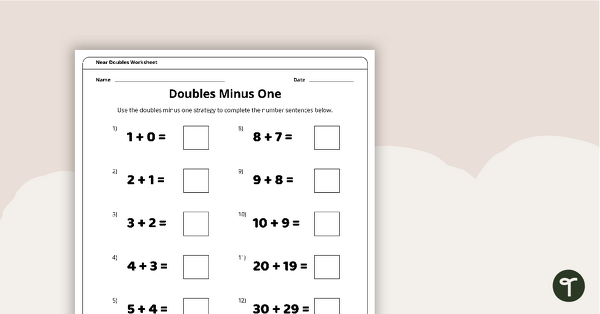
Practice the doubles minus one addition strategy with this one-page worksheet.
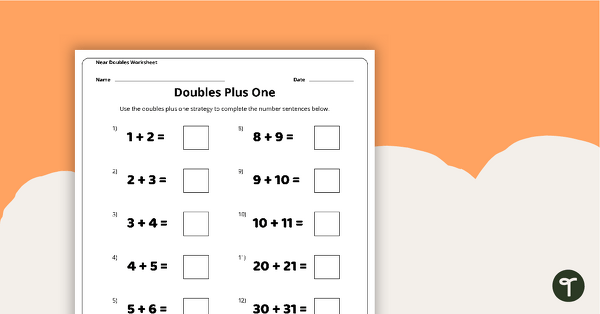
Practice the doubles plus one addition strategy with this one-page worksheet.
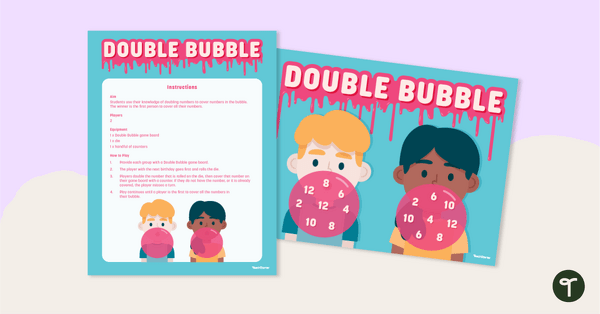
Practice the doubles addition strategy with this fun board game.

A fun game for students to play when learning to double two-digit numbers.
0 Comments
Write a review to help other teachers and parents like yourself. If you'd like to request a change to this resource, or report an error, select the corresponding tab above.